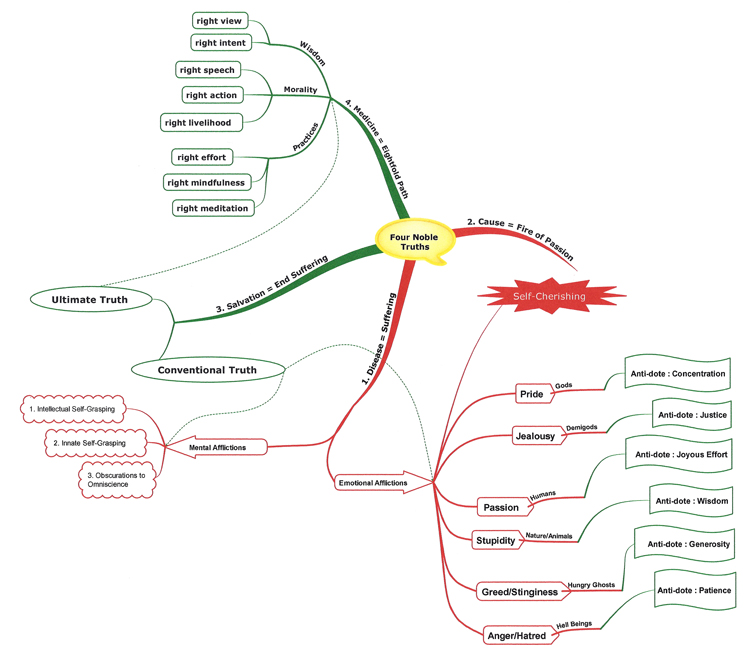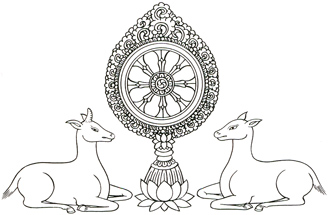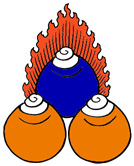| |

Studies
in
Buddhadharma
On the
Four Noble Truths
 Contents
Contents  SiteMap
SiteMap

"Whatever is subject to origination is all subject to
cessation."
Samyuktâgama
(Samyutta-nikâya), 56.II, verse
423.

The Truth of Suffering
The Truth
of Arising
The Truth
of Cessation
The Truth
of the Path
|
|

The First Turning of
the Wheel of Dharma
in the Deer Park at Sarnath |
|
|
The wheel
("dharmacakra") and the motif of two deer flanking Śiva predate the
Buddhadharma. In a Tibetan mandala, it may be placed over the
four gateways. Common at the centre of the monastery and/or temple
roofs, it represents the Buddhayâna
as a whole.
Note how the Wheel of Dharma springs out of the Lotus, symbol of our
Buddha-potential. Moreover, in tune with traditional Indian
polarity placement, the male (Solar) unicorn is on the right side of
the Wheel, the (Lunar) female deer on the left. Both
Mahâyana &
Vajrayâna "expansions" are thus part of the image.
After his enlightenment,
Buddha
Śâkyamuni returned to the Deer Park at Sarnath, close to Kaśi,
the "city of light", considered sacred to Śiva and later known as
Vârânasî or Benares. This park was probably a sacred grove dedicated
to Śiva Paśupati, "Lord of Cattle", used by Shaivite yogins.
By delivering his first discourse to his five ascetic companions,
Śâkyamuni was the first Buddha of our time to turn the Wheel of
Dharma.
|
In the First Discourse, the
wisdom
leading to enlightenment or the realization of things as they are, was
taught by the enlightened Śâkyamuni in terms of four interlinked
propositions known as the Four Noble Truths ("cattâri ariyasaccâni"),
covering the central tenets of his
Buddhadharma.
This crucial First Discourse of Buddha Śâkyamuni can be found in the
second basket of the
Tripitaka as
: "Setting in Motion the Wheel of the Dharma"
(Samyuktâgama, 56.II).
The Four Noble Truths follow the pattern of a medical anamnesis :
(a) diagnosis : what is at hand ? = suffering ;
(b) identification of causes : what feeds
suffering ? = lust & unlust ;
(c) curability : what ends suffering ? =
wisdom ;
(d) method of
treatment : how to be wise ? = experience emptiness.
Experiencing emptiness results from purifying & training the conceptual mind. Logic,
epistemology, science & metaphysics define this mind's rational,
conceptual understanding of emptiness ; an approximation. Meditation trains the peaceful,
tranquil mind of
Bodhicitta, leading up to concentrated insights & direct nondual
realization of emptiness.
The nobility of these Four Noble Truths lies in their intention to radically change
the human condition, and bring about a true peace which, once attained, depends
on nothing. This is not a revelation, but the discovery of the ultimate
nature of things by way of
reason &
meditation.
Unenlightened, sentient beings inevitably cycle around dis-eased. There is
only one solution : end "samsâra" ! To
eradicate the root of the illness, the mind must be healed. This all-encompassing
intention is the splendour of the Four Noble Truths, for in principle all
sentient beings can enter "nirvâna",
being liberated
and/or fully enlightened (Buddhahood).
If this is the view, then, not unlike Pythagoras, Śâkyamuni was one of the
first philosophers of humanity. Perhaps Śâkyamuni's criticism & nominalism
are even more outstanding than the harmony of the spheres and the theorem
on which it is based (for the latter are dependent arisings).
The Four Noble Truths work on all levels of interpretation. Discussed at
the coarse level, they introduce the Buddhadharma succinctly.
1. THE TRUTH OF SUFFERING
Diagnosis : caught in & trapped
by cycles,
sentient beings suffer ;
Suffering ("duhkha") is the condition of disabled, afflicted sentient beings. Birth,
sickness, old age & death are exemplaric of the transient nature of
human beings trapped in "samsâra", conditioned by the five factors of individuality ("skandhas")
: physical body ("rûpa"), feelings ("vedanâ"), cognitions ("samjñâ"),
dispositions ("samskâra") & consciousness or sentience ("vijñâna"), also
called the "aggregates of attachment" ("upâdâna-skandha").
A more contemporary classification includes sensation, volition, affection
(etc), cognition and consciousness.
"Duhkha", translated as "suffering" or "unsatisfactoriness", literally
means "contracted space", suggestive of the claustrophobic limitation imposed upon our
fundamental nature, deemed spacious, open, fluid & free. So "duhkha" may
be contrasted with "sukhâ", the open spaciousness of bliss. This
ultimate state of enlightenment is without obstructions and so, depending
on nothing, cannot be opposed. It is beyond happiness and unhappiness.
Beyond peace and war. This is true peace, or "hyper-peace" (as
ps.-Dionysius would say).
The First Noble Truth calls for wakefullness in the face of all forms of
suffering, from general unsatisfactoriness, up to physical pain, mental
agony and the pervasive nature of suffering throughout the world system(s).
Only by being aware of suffering can we possibly eliminate it. Buddha
seeks out our suffering to disrupt our tendency to daydream away from it,
unwilling to take note of it (either because it hurts too much or because
we consider a remedy inexistent). He turns our attention to the
possibility of eradicating suffering for good, and in doing so end the
four tides of suffering : birth, sickness, ageing and death. Bringing in
the effort necessary to transform the mind thoroughly, propels one to
liberation & full enlightenment.
If the First Truth would stand alone, nothing would be gained. This is not
the case. With the truth of suffering, Śâkyamuni, as would a medical
doctor, points to the obscured & afflictive state of our deluded condition in
order to trigger our attention, incite us & empower us to irreversibly
transform it into the better, healed, whole clear state, i.e. "nirvâna",
the absence of suffering, true peace. He puts his finger to the
wound, so we may become aware of the pain. Origination implies cessation.
Absence of true peace : all states of mind & body in which
clinging ("upâdâna") inheres, cause suffering : clinging to a wrong sense of
reality (ignorance), clinging to pleasurable states (desire) and clinging
to absence of unpleasurable states (hatred).
The truth of suffering is intended to fire up our spiritual
vehemence. There is still a lot of work to be done, and the sooner we put
in the right effort, the quicker results will be forthcoming, i.e.
suffering eradicated. Suffering will not go away by itself, and physical
death does not end it either. Nobody can do the work for us. There are no
true Saviors.
Pervasive suffering is a theme also found in Hinduism
:
"Because of the sorrow present in the transformation of Nature, in its
anguish, in its reactors and due to the conflict between the movements of
Nature, to the discerner all is merely sorrow."
Patañjali : Yoga-sûtra, 2.15.
In Tibetan Buddhism, one meditates on (1) the suffering of suffering,
or the experiences of physical & mental pain and anguish, (2) the suffering of change,
bewailing the impermanence of peace & happiness and (3) the pervasive
suffering, the one underpining "samsâra" as a whole and the cause of apathy.
The last
kind of suffering is the most difficult to discern. Although material
wealth, sensate gratification and certain mental hallucinations are pleasurable, in the long run they
cause new material, emotional & mental suffering. Over time, the marginal
surplus of material increase decreases. The more the body ages, the more
spiritual needs become important. On this very subtle level of suffering,
one identifies the whole of cyclic existence or "samsâra"
as unsatisfactory & transient. As all pleasure ends, at all times suffering
is only temporarily releaved. The body inevitably returns to the butcher's
block !
To come to this conclusion is not to endorse pessimism, but to maintain a
realistic view on cyclic existence. On the contrary, the object to be
eliminated is clearly established : suffering.
The Buddhadharma is intelligent & good because
right effort brings permanent bliss. There is no "creda quia absurdum"
in the Buddhahdarma. This is science of mind before being a flowering of
goodness. Permanent bliss is not self-powered, self-settled, or inherently
existing bliss, but the nondual savouring of the continuous
symmetry-transformations or perfect kinetography of an enlightened
mindstream ; a perpetual perfect dance.
In principle this can be now, in our old age and/or
after our body dies.
2. THE TRUTH OF ARISING
Etiology : craving chains sentient beings
to cycles ;
The Second Noble Truth involves an analysis of the causes or arising
("samudâya") of suffering, defined as ignorant
craving or "thirst" ("triśnâ") for sensual pleasure, for self-annihilation
(as in nihilism and classical ontological materialism) or for the supposed
"eternal"
existence of the gods. Desire is sensate, involving the five
sense-consciousnesses and based on attraction. They are the roots of the
afflictive desires or negative emotions. Repulsion or hatred is mental,
whereas ignorance about the true nature of phenomena leads to grotesk
reifications, like a self-powered soul ("âtman") or a self-sufficient God
("Brahman").
Mental delusions & afflictive
desires constitute the Three Poisons or unwholesome roots ("akuśala"),
forming the hub of the wheel of suffering. Ignorance designates objects as inherently
existing from their own side. Craving
grasps (affirms) the object. Hatred dislikes
(negates) the object. In milder form, hatred is the mental tendency to
push something away, while mild craving is the mind's tendency to attract.
The cause of suffering is therefore not an
abstract principle, but something active and purposive, i.e. and agent.
Craving makes each facet of experience to be aflame. This is an
emphatic "yes" or "no". It comes
into being and settles itself in lovable and gratifying experiences, and
in what gives relief or escape from what is unpleasant and undesirable.
Non-afflictive desires are not under attack here, only the ignorant craving causing
suffering. This points to the root of this craving : nescience, delusion or the
absence of the wisdom-mind realizing the ultimate nature of phenomena.
Analyzing this further, we discover this craving to be an afflictive desire to
have, grasp or possess
something else than what present experience gives, a ceaseless striving
for some new state or experience, a lust for something else than what is
presently at hand ... Suffering is rooted in continuous activity on the
basis of short-lived impulses, as it were "making experience". Mind arises
& ceases, "just as a monkey ranging through a
forests seazes a branch and, letting go, seizes another." (Samyuktâgama, II.95).
The truth of arising also shows how every effect has a cause, how
everything comes into being in dependence on something else, in endless
cycles of co-determination. This conditioned, interdependent arising
("pratîtya-samutpâda") is known as the "causal nexus",
the universal interconnectedness between all possible phenomena. In this
conditioned, cyclic, conventional existence, all arising phenomena bear
the Three Marks of Existence ("trilakśana") : impermanence ("anitya"),
suffering ("duhkha") and selflessness ("anâtman"). They arise, stay for a
while and cease. They crave and so suffer. Never remaining identical, they
exist interdependently. What does not arise cannot cease. What cannot be
observed cannot be told.
By knowing the causes of suffering, namely, on the one hand, the afflictive states of
our emotions
(craving & hatred), and, on the other hand, the deluded activity of
our mind
(ignorance), a cure can be sought.
3. THE TRUTH OF CESSATION
Curability : the suffering of all sentient beings can be ceased ;
The truth of cessation ("nirodha", also "destruction, dissolution") manifests
a revolutionary solution : the Three Poisons, the roots of all possible
emotional afflictions & mental delusions, can be irreversibly destroyed. Cessation implies the end of
suffering. A path to the final end
of all possible suffering comes in sight. To liberate sentient beings from
suffering, the necessary path of merit
has insufficient
power on its own, for wisdom is also necessary. Brahmanism has no supramundane exit, only a
transient cosmic
consciousness (cf. the Peak of Existence - the heaven of Brahmâ).
The fact of cessation manifests the ultimate nature of phenomena :
emptiness. Not a
subsisting, abiding foundation or ontological ultimate, emptiness yoga
trains an ultimate bliss beyond affirmation & negation. This bliss cannot
be the object of the coarse, conventional, nominal, conceptual mind. The latter is
chained by the ontological illusion making sensate and/or mental objects
appear as established by way of their own, independent character.
Emptiness, the ultimate nature, is unsubstantial and devoid of own-form
(cf. the emptiness of emptiness). Nameless, emptiness ever remains a
Divine Mystery unfolding a Divine Energy-Play.
Cessation cannot be realized without a radical change of mind.
By positing (designating) the end of suffering, Buddha manifests
enlightenment as
unaffected by the turbulent nature of the aggregates of cyclic existence.
The truth of cessation leads to the simultaneity of the
Two Truths, namely
the conventional truth ("samvriti-satya") of the suffering of cyclic existence and the
ultimate truth ("paramârtha-satya") of the cessation of suffering, "nirvâna" or
true peace. The cure
is a matter of two components : the
merit
or method (which is the truth of
the path leading to compassion, necessary to deal with conventional truth) and the
wisdom of cessation (necessary to
prehend ultimate truth). The latter immediately points to the ultimate
cause of suffering : our ignorance about the true nature of things (hence,
attachment to conventional reality) and the fickle nature of our emotions,
with their cohesive and repulsive polarities, their loves & hates.
Buddha's cure is not something learned, but part of his intimate
experience. As a
Bodhisattva he had already accumulated
massive amounts of merit. His birth was that of an exceptionally gifted &
precious human being. But the meditations of this exceptional, legendary Bodhisattva did
not end suffering. The "traditional" techniques, based on the
accumulation of good karma through austerities (renunciation), brought this dedicated trainee only
to a certain point within "samsâra". After six years, the traditional methods of
ascetism were exhausted.
The truth of cessation is the wisdom of the Buddha, directly related to
the Two Truths. Experiencing the ultimate nature of reality is the outcome of ending
ignorance by realizing emptiness, uprooting all emotional afflictions.
Extremes are avoided by realizing the "middle ground" of not too
much and not too little, ending mental delusions and painful, afflicted
emotions. Objects do not exist on their own, but as part of an interrelated
network of other objects. The relata or not the focus here, but the
relation.
Some Buddhist celebrate the advent of this truth as the moment Buddha
Śâkyamuni saw the "house-builder", the fundamental cause of this flawed
existence (cf. Dhammapada, verses 153 - 154). What did he see ?
Buddha saw (a) his ego without any self-identification or measurement
(renounced) -or the emptiness of the self- and (b) the functional,
interdependent world around him with compassion and without own character
or independent substance ("svabhâva") : the emptiness of phenomena. He summoned the
Earth to witness his exceptional condition.
The Truth of Cessation defines the difference between conventional reality
and ultimate truth, introducing the
Two Truths.
4. THE TRUTH OF THE PATH
Treatment : train in ethics, meditation &
wisdom ;
The therapy or path ("marga") proposed by Śâkyamuni is the Treefold
Training ("triśikśa"), one unlike Vedic rituals & yogic practices of his
time, and therefore deemed "unorthodox". It does not appeal to any
eternalized subject (or "âtman"), nor to an eternalized object (or
"Brahman"). These three "higher" trainings involve
morality
("śila"), the practice of
meditation ("samâdhi") and
wisdom ("prajñâ").
These cover the entire
Buddhadharma. They are interdependent conditions, and
so all three need to be present in order for the cure to have effect (the end of
suffering). It is that simple.
The Buddha's approach of both
merit and
wisdom is revolutionary.
It does not suffice to offer to the Deities or accumulate mere "good" karma
(which exhausts itself). The "merit" collected is dedicated to the welfare
of all sentient beings, and so connected to a very vast field or network,
by intent infinite. Although one may choose, as in the
Lesser Vehicle, to
focus on personal liberation, merit is never collected for one's own sake.
Hand in hand with this view on personal effort, the wisdom of
Śâkyamuni seeks to experience reality as it is, not as it is
conceptualized and then substantialized. His wisdom cuts through illusion
while the illusionary appearance remains. This "cutting through" targets
the eternalization or reification of conventional reality, not conventional reality
itself. The path does not end with "another" reality to be revealed,
better than anything else one can conceive as best (a "summum bonum"), but with
the same reality
perceived as emerging, abiding and submerging in an endless
interconnected, functional field, empty of an everlasting substance,
never essentially
enduring from its own side, a sacred unbounded wholeness. Emptiness is not the substance of all
things, but the characteristic of each and every thing. It is not only a
state of mind, but also an object to be experienced.
The Threefold Training is explained in the
Eightfold Path.

|
|





